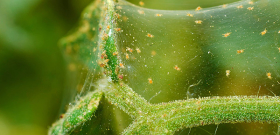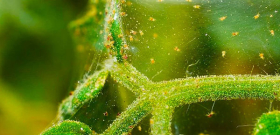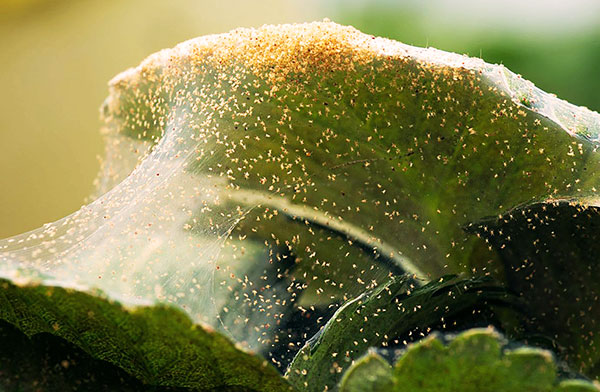
A spider mite is a pest that needs to be fought immediately after it is found on a plant, no matter if it is a small bush in a room pot, or an adult fruit-bearing tree in the garden. Any plant can be very severely affected by ticks, and in a certain situation, with additional exposure to other adverse factors, it may even face death.
In any case, the main desired properties of any plant are lost when it is damaged by tetranychids. If the plant is fruit-bearing, then, being ticked, it loses its yield, some of the fruits on it do not ripen, or do not grow to the desired size and weight. And sometimes, in the conditions of early spring, tick damage can provoke a complete shedding of flowers and ovaries.
In ornamental plants, damage by spider mites leads to the appearance of ugly brown spots on the leaves, gradual drying and falling off of leaves and entire shoots. As a result, the appearance of the bush is greatly deteriorated.
Be that as it may, it is possible to get rid of the spider mite only as a result of a targeted struggle using effective methods of destruction of both adults and nymphs at different stages. By themselves, they will not disappear and the plant will not recover by itself.Moreover, in some cases (for example, in gardens and perennial flower beds), it is necessary to fight the tick almost constantly due to the constant introduction of new individuals, preventing them from multiplying in quantities that threaten plants. And in other situations, urgent measures must be taken immediately if the conditions in which the plant is located are optimal for ticks, and they have no enemies here. If this is not done, then in a matter of weeks you can lose your favorite bush.
Such a fight should begin with an assessment of the current state of the plant and the tick population on it, so that the measures taken are adequate to the severity of the infection.
How to understand that a plant is affected by a spider mite
At different stages of infection, the plant shows certain signs of vital activity of tetranych mites. Moreover, it is important to diagnose the presence of pests as early as possible in order to get rid of them as quickly as possible, with the least hassle and minimal harm to the plant.
All traces of the presence of mites on the plant appear in the following order:
- First, tiny, barely noticeable white dots appear on the leaves in those places where the mites pierce the cell and suck out the juice from it. In fact, these are just cell walls remaining between still intact cells. At this stage, they are not conspicuous, but notice them if they accidentally examine a leaf in the sun. It is easier to see such points on a tree on the street, looking at it from the bottom up, and so that the leaf is located between the eye and the sun. These empty spaces will show through. The thinner the leaves, the easier it is to see these dots. For example, they are clearly visible on an apple or cherry tree, it is difficult to see them on an orchid, and it is almost impossible to see them on coniferous trees.Also, they can be easily seen on seedlings of the same peppers or tomatoes, and it is already more difficult to find them on adult bushes;
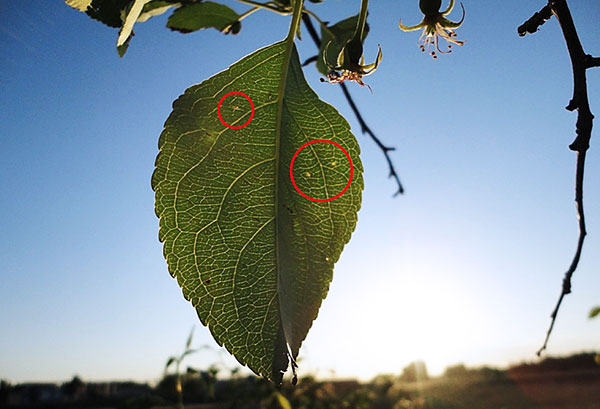
Apple tree leaf with mite infested areas barely visible in the sun.
- As nearby cells are damaged, they merge into large spots that are brown, gray or brown in color. This is the most characteristic and the first of the signs visible to the naked eye;
- Gradually, the most affected leaves and areas of shoots dry up due to metabolic disturbances and lack of photosynthetic area;
- After 2-3 generations after the initial infection, a white cobweb begins to appear on the underside of the leaves, similar to translucent fluff. Over time, it becomes thicker, covers the leaves on both sides and entangles entire shoots. It is already possible to examine ticks on it without special devices;
- Closer to autumn, noticeable clusters of adult tetranychids appear in different places of the plant. They look like small red spots and are more often found at the base of leaves and branches. If you look at them through a magnifying glass, you can see the individual ticks that make up such a cluster. However, this sign appears when, according to other criteria, a person already understands that the tree is infected with mites.
On a note
Flat mites are often confused with tetranych mites. Outwardly, they are very similar to cobwebs, causing the same harm, but do not form a web. In addition, flat beetles can infect plants on which spider mites never settle, in particular Saintpaulias and some other species of the Gesneriaceae family. Therefore, when examining a plant, one must keep in mind that there may be harmful mites here, and the web may not be found.
At all stages, if you suspect ticks, you can try to find them with a magnifying glass or a field microscope. It is difficult to see isolated mites with the naked eye because of their small size, but it is enough to look at a leaf with characteristic features through a magnifying glass, how pests are found on it - they have a reddish or yellowish body, actively move, and in some places form clusters.
The photo below shows what adult spider mites look like under a microscope:

As well as a view of the accumulation of females preparing to leave for winter shelters:

In plants in open ground in temperate and subtropical climates, these signs begin to appear in April-May. Approximately from the end of March to the beginning of April, as soon as the daytime air temperature rises above 12°C, the overwintered females emerge from their shelters in the soil and bark, climb onto branches and leaves, and begin to feed. Their number at this time is very small and traces of their nutrition are almost invisible. Already from the first days of activity, they begin to lay eggs, from which larvae emerge and also begin to suck the juice from the cells. After about 2-3 generations, which develop for a month and a half, there are already quite a lot of mites, and dots on the leaves at the places of their punctures can already be detected with the naked eye. At the same time, you can already notice marble or brown spots on the leaves.
On a note
Interestingly, the most notorious pest of outdoor plants of all spider mites is the common spider mite (it is found worldwide and harms more than 200 species of cultivated plants), and indoor plants are most often affected by the red spider mite.
A little later, in June-July, the reproduction of ticks accelerates due to the high air temperature.Their full reproductive cycle is reduced to 10-12 days, there are a lot of ticks. At this time, their clusters and cobwebs, with which they braid leaves and shoots, can be detected.
In August-September, on the affected plants, the cobweb is already very clearly visible, which appears not only on the underside of the leaves, but on all their surfaces. At the same time, wintering females begin to appear in the population. They differ from the yellow-green "summer" progenitors with a red body and increased frost resistance. Upon reaching adulthood, they mate with males, and then climb into secluded places in the bark or descend into the soil to overwinter. It is their clusters that are easiest to notice with the naked eye on the trunks, leaves and branches of trees.
It is interesting
Females of the common spider mite from summer populations die when the air temperature drops to 0°C, while wintering females in shelters safely survive frosts down to -27°C. Actually, the range of this species around the world is limited by latitudes where the air temperature in winter drops below this mark - its representatives can no longer live here.
Such signs can be found on any plants. Spider mites are extremely omnivorous and infect almost any kind of garden, garden, ornamental and indoor plants. For example, with the same success with which they harm raspberries or pears, they can also feed on strawberries, balsam, hibiscus, ferns, marigolds, ficuses, brugmansia, various palm trees, and even succulents - cacti, aloe, lithops and others.
The photographs below show what leaf damage by spider mites looks like on different plants. Here is an example of a lemon:

This is a raspberry with obvious traces of pest activity:

And here is the honeysuckle:

The only exception to such a wide diet of spider mites are plants of the Gesneriaceae family, the most famous of which is Saintpaulia, or Usambara violet. Spider mites do not harm these plants and do not settle on them. However, they are also harmed by flat mites, which, without special equipment and identification tables, are practically indistinguishable from cobwebs in appearance. Their only difference is that they do not weave a web, but in other respects they are identical to tetranychids. The main thing is that they are just as dangerous as spider mites, and you need to fight them with the same methods, so their strict identification is of no practical importance.
So, when you find either signs of the presence of ticks, or themselves, you need to choose the appropriate method of struggle and destroy them.
Spider mite control methods
To date, there are several methods for the destruction of spider mites, different in efficiency, ease of implementation and cost. In a given situation, you should choose the most suitable of them, and the best solution would be to use a combination of several methods. These methods include:
- The destruction of ticks with various chemical acaricidal preparations is the most affordable, widespread and quite effective way. Suitable for all plants, for use outdoors and at home, often does not require special equipment and can be implemented at any scale - from spraying a single bush in a pot to processing garden complexes on an area of thousand hectares;
- The use of drugs of hormonal and intestinal action against ticks (they are also called biological acaricides). In practice, this method differs little from the use of insecticides, but the principle of action of the means used with it is different - these drugs do not kill ticks, but prevent their development or reproduction. The result is similar - the tick population is gradually dying out;
- The use of biological control methods - natural enemies of spider mites. Today, the use of predatory phytoseiulus mites for this purpose, which feed almost exclusively on tetranychids and their eggs, has been well developed. Reproducing almost as fast, they can completely destroy spider mites over a fairly large area in a short time;
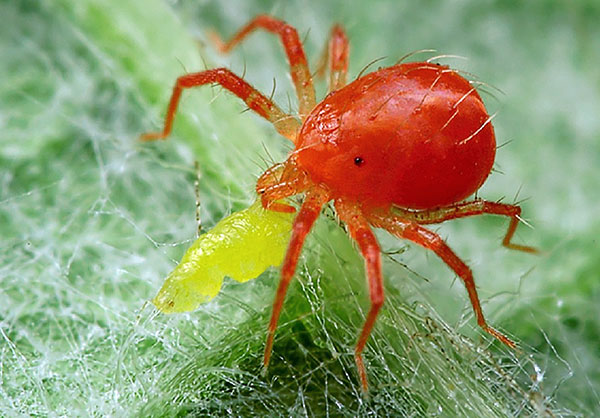
The predatory mite phytoseiulus is a natural enemy of both spider mites and other plant pests.
- Agrotechnical measures aimed primarily at the destruction of wintering individuals or the prevention of infection of plants by them in the spring;
- Destruction of ticks due to temperature changes, applicable in a very limited number of cases.
As a rule, for the destruction of ticks on one or two bushes or in a small area - in a vegetable garden, a small garden - the use of neurotoxic or hormonal acaricides in combination with competent agricultural technology is optimal. In large farms - in large greenhouses, in industrial gardens, nurseries - it is rational to carry out biosecurity using predatory mites, and the choice between them and the use of chemical insecticides is made on the basis of financial calculations.
Simply put, at home or in a summer cottage, it is easiest to destroy spider mites with chemicals or bacterial acaricides.
Chemical acaricides and general rules for their use
All preparations based on chemical acaricides have an acute neuroparalytic effect on ticks that are at the active stages of development - larvae, nymphs and adults. After the active substance enters the body of the pest, first a strong excitation develops, then muscle paralysis, after which death occurs.
The active substances in these preparations are divided into several groups - pyrethroids (synthetic derivatives of pyrethrins - components of the inflorescences of plants of the genus Pyrethrum), organophosphorus preparations, neonecotinoids, carbamates. The speed of their action on ticks varies somewhat, but from a practical point of view, this difference is insignificant.
The drugs in this group include:
- Karbofos, Fufanon, Fufanon-Super, Antiklesh - products based on karbofos (aka malathion);
- Karate-Zeon, Shaman, Vega, Lightning - drugs with active ingredients - pyrethroids;
- Commander, Imidor, Warrant - products based on neonicotinoids;
- Abamectin, Aversectin, Fitoverm, Vertimek and others based on avermectin substances (they are obtained from mushrooms specially grown for this).
Any of these funds is used in the form of a working solution of the drug in water. The plant is sprayed with this solution so that the liquid gets on the affected leaves and branches, and most importantly, on the mites themselves.
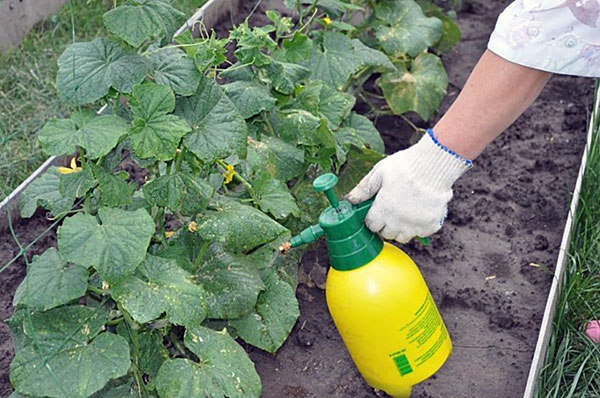
In the chemical fight against spider mites, the active drug must be diluted in water and the plant should be sprayed with the already obtained solution.
If spraying is done indoors, then a simple household spray gun is used. When processing plants in a garden or vegetable garden, either a manual garden sprayer or a motorized sprayer is needed.
In large farms, aircraft or drones can be used to spray these funds.
It's important to know
To combat ticks, you need to buy exactly drugs based on acaricides or insectoacaricides. Some gardeners believe that if they sprayed the tree with some kind of protective agent, then this will be enough to prevent ticking. So there are situations when, for some reason, fungicides are used for ticks (for example, powdery mildew remedy Topaz), highly specialized bacterial insecticides, and even growth stimulants that do not work on ticks at all.
Sometimes these products are sold in the form of powders or special smoke bombs. The former are not suitable for processing plants, since their consumption is too high with low efficiency due to poor retention on the plant, and the latter are irrational, since the entire room will have to be smoked to process one or two bushes. If, for example, croton or a small ficus can somehow still be treated with powder and the product settles on the leaves, then it is impossible to effectively pickle a large plum in the country or a juniper with thin needles with a product in this form.
In the open air, bushes and trees, in principle, cannot be effectively treated with powders, and the smoke from the checker will not have time to poison the ticks before it disperses in the air.
Plants affected by spider mites should be sprayed with an acaricidal solution as soon as possible after the pests are detected. With proper treatment, most of the active mites will die, but the eggs will survive (chemical insecticides have little or no effect on them). Larvae that hatch from these eggs and mites that survive the first spray will need to be re-etched 5-6 days after the first spray.
For re-treatment, it is advisable to use a different agent that was used for the first time. This is due to the fact that ticks quickly develop resistance to acaricides and some of the surviving pests may be resistant to the applied agent. The probability of such resistance to two substances of different groups at once is negligible.
It's important to know
Repeated spraying should be carried out no later than 7 days after the first. Under suitable conditions, the full development cycle of the spider mite proceeds in 8-10 days. If on the day of the first spraying larvae hatch from the surviving eggs, most of them will die, but after 8-10 days some individuals will be able to turn into adult mites and start laying eggs. If such a development of the situation is allowed, then repeated treatments will need to be carried out constantly. If the plants are re-sprayed on the 5th-6th day, then larvae will hatch from all the eggs, but none of them will have time to develop into adults and they will all die during repeated processing, leaving no eggs.
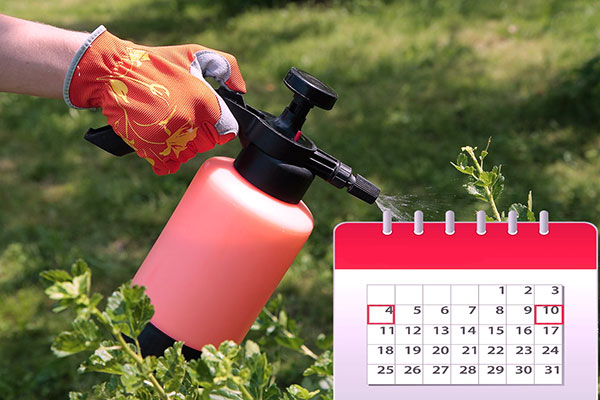
Re-treatment against spider mites is carried out 5-6 days after the first.
It is believed that the use of chemical insecticides is best combined with the use of biological agents, since due to the differences in the principle of action, such combinations can kill all pests.
Physiological preparations
The fundamental difference between the drugs of this group and chemical acaricides is that they act on certain physiological mechanisms in the body of ticks and, without killing them, lead to the cessation of reproduction in the population.
For example:
- Oberon, Judo, Envidor inhibit the synthesis of lipids in the body of ticks and block the development of the outer integument of the body in nymphs and larvae, the development of eggs in the body of females and the development of embryos in eggs. This is one of the few remedies that act on tick eggs;
- Flumite and Apollo, leading to sterilization of females and preventing molting and transition to the next age in nymphs. They also act on eggs and block the exit of larvae from them.
A notable feature of these remedies is that they do not kill ticks quickly. Therefore, the optimal strategy is to treat the infected plant with a nerve acaricide and then fix the result with a biological product.
These agents are used in the same way as the acaricides described above. They are produced in the form of concentrated preparations, which are diluted with water and applied from a spray bottle to infected plants.
On a note
Despite the prefix "bio-..." in the names of these drugs, they are no less toxic to humans than the nerve acaricils. When using them, it is necessary to observe safety measures and use personal protective equipment.
Methods of biological control of spider mites
For the biological control of spider mites, phytoseiulus and amblyseius mites are most often used.
This is what an adult Phytoseiulus persimilis looks like:

And so - Amblyseius californicus:
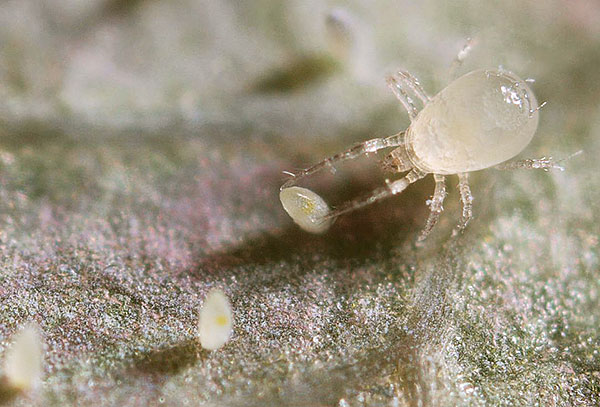
An adult individual of such a predator eats 1-2 adult spider mites per day, or 10 nymphs, or up to 30 eggs. In the presence of a large food base, predatory mites multiply rapidly and completely eat away the entire population of tetranychids. At the same time, they are absolutely harmless to people, animals and most insects, they can be completely safely settled on plants at home.
In fact, these mites are considered the best means of destroying spider brethren in greenhouses, large greenhouses, and in the warm season and in some regions, in ordinary industrial gardens and farms.
Until recently, they were also considered an irrational tool for small private farms due to the high cost and difficulty in buying small lots. Today, however, manufacturers of these ticks are already selling them in small quantities - from 10,000 individuals - and at quite affordable prices. For example, the cost of 10,000 Amblyseius californicus is about 3,000 rubles, and the price for a batch of 25,000 is 7,500 rubles. This amount is quite enough to eliminate spider mites during the summer season on a plot of 6-10 acres, or in a greenhouse located on the same territory.
So, when buying ambliseius, it is recommended to plant 10-30 individuals per small infected bush of a houseplant. In the garden, about 100 individuals should be placed on an infected tree. That is, the minimum batch of these mites is designed to destroy tetranychids on 100 mature trees and shrubs.
Agrotechnical control measures
Agrotechnical measures are used in addition to other control methods, but by themselves do not allow the rapid and complete destruction of spider mites.
These measures include:
- Destruction of weeds, especially perennials, which can be fodder plants and breeding grounds for mites;
- Autumn plowing of vegetable gardens, digging near-stem circles of trees - this allows you to freeze out some of the pests that have left for wintering;
- Removal of old bark from trees and bushes, under which individual individuals can hibernate. It is useful to burn this bark;
- Collection and destruction of fallen leaves, which may contain eggs and active stages of mites.
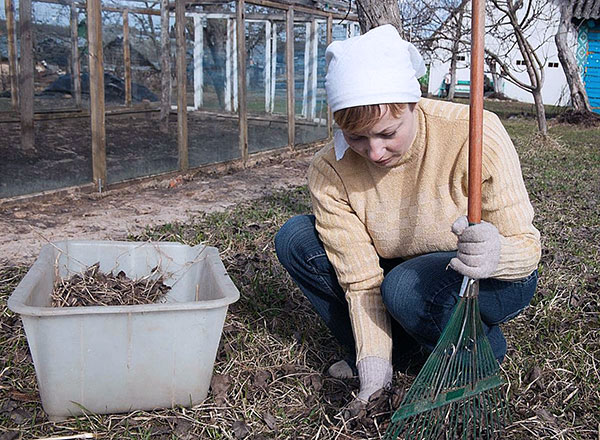
One of the agrotechnical methods of dealing with spider mites is the destruction of fallen leaves.
To a greater extent, such measures are taken to prevent the growth of the number of spider mites in subsequent years.
On a note
It is important to understand that getting rid of the spider mite forever is unlikely to succeed even at home, not to mention street flowers and fruit trees. Ticks can get on them with the wind, with new soil, from pots with new plants. Nevertheless, preventive measures and emergency extermination of ticks during their mass reproduction make it possible to avoid the deplorable consequences of their vital activity.
What is important to know about temperature control methods
The destruction of mites by extreme temperatures can only be considered as a very limited "shock" therapy for houseplants. The fact is that street trees or bushes are almost impossible to warm up to 50-60 ° C, or cool down to -4-5 ° C in summer because of their size. But indoor plants are quite subject to such "treatment". For this you can:
- In winter, take the infected bush out into the cold for 3-4 hours, repeat such a “shake” the next day.Most citrus fruits, decorative indoor spruces, geraniums, chrysanthemums, petunias, gardenias (including jasmine-like ones) will not suffer from such hardening, and mites will freeze out for the most part in these few hours;
- If the bush is small, then for the same few hours it can be placed in the freezer of the refrigerator. This is sometimes done with fat women, cacti, low bushes of fuchsia and tangerines;

Sometimes a houseplant affected by a spider mite is placed in a freezer for several hours.
- On the contrary, the bush can be taken out to the balcony, located on the sunny side, and the door closed here, or placed in a car left in the summer in the sun. So sometimes ticks are removed from anthuriums, benjamins and adeniums. Similarly, a room with a plant can be heated with a heat gun, if it is available on the farm.
A similar procedure can be carried out on the street using a steam generator - branches and leaves of plants are sprayed with a stream of steam. Low young fruit and ornamental trees - apple trees, pears, cherries, lilacs, magnolias, arborvitae - will not suffer from such steam treatment, and mites die almost instantly when burned with steam.
Is it advisable to mechanically kill spider mites?
But what exactly is useless to do is to try to find ticks, crush them with your fingers or shake them off the leaves. Due to their tiny size, it is extremely difficult to notice them all, and it is even more difficult to pass them all. Especially considering how many of them can be in the axils of the leaves inaccessible to the fingers.
It will not work to shake them off the leaves due to the fact that even at the early stages of infection, a cobweb is formed on the leaves, albeit inconspicuous, but sufficient for reliable attachment of ticks.
Similarly, it will not be possible to collect ticks with a vacuum cleaner, and even more so to find and pass the eggs of these pests with your fingers. Their eggs are so small that just finding them without a microscope will not work, and examining every millimeter of even a small bush with a microscope is a pure gamble. A vacuum cleaner won't pick up the mites for the same reason that you can't shake them off - each tick is held onto a web.
Folk remedies to help get rid of pests
The use of folk methods from spider mites is a kind of cornerstone in the practice of crop production.
On the one hand, some of these methods are effective and allow you to overcome ticks. In particular, soap and water, a decoction of garlic or onions, dishwashing detergents, alcohol really kill ticks and sometimes even their eggs. On the other hand, such agents are less effective than specially designed insecticides, and therefore the fight against them is more difficult and lengthy.

Folk ways to deal with spider mites on plants.
In addition, folk remedies can effectively remove spider mites only from indoor plants, or from indoor seedlings. To process garden plants, such quantities of these home-made preparations will already be required, which are difficult to prepare on their own. And how these same funds will affect other insects, including beneficial ones, is not known.
In other words, folk remedies can be used on a test to control ticks on houseplants. If they work, it will be good. If they don’t help, it won’t be scary, because a lot of money won’t be spent on it, and after them it will always be possible to use effective acaricides.
Combination of different methods for the fastest and complete destruction of spider mites
Ultimately, for a successful fight against spider mites, it is highly desirable to combine several methods. Such a double or even triple blow ensures not only the complete destruction of ticks, but rather effective prevention of their mass reproduction in the future.
As a rule, the most effective combination of biological preparations with acaricides of acute nerve action. First, biological ones are applied, which lead to the cessation of reproduction in ticks, then the ticks are poisoned and die. Even if some of them survive, they will no longer produce offspring and the outbreak of pest growth will be eliminated.
This is true for any conditions - both for removing ticks from gerberas on the balcony, and for their destruction on apricots in the garden. Moreover, with the right selection of funds that have not only an acaricidal, but also an insecticidal effect, such treatment can simultaneously get rid of tetranychids and other pests - aphids, scoop caterpillars, some sawflies and scale insects.
In the garden and garden, it is recommended to combine the use of acaricides with agrotechnical methods. It is this combination that makes it possible to prevent a large number of outbreaks of ticks.
The same agrotechnical measures should be carried out in greenhouses and greenhouses. In winter, at least for a short time, each greenhouse should be frozen out, having previously loosened the ground here, in order to be sure that the female ticks that have left for the winter have died.
At the same time, it is impossible to combine methods of biological plant protection with the use of acaricides, since predatory mites die from the action of acaricidal agents as quickly as spider mites.
Finally, even with the apparent absence of ticks and signs of their activity in early spring, tree branches should be treated with acaricides for prevention. This will ensure that even if individual females have already left their winter shelters and entered the feeding and breeding grounds, they will be destroyed and their offspring will no longer create mass accumulations that are dangerous for plants.
Useful video about the fight against spider mites. Candidate of Biological Sciences V. Kiryushin tells

